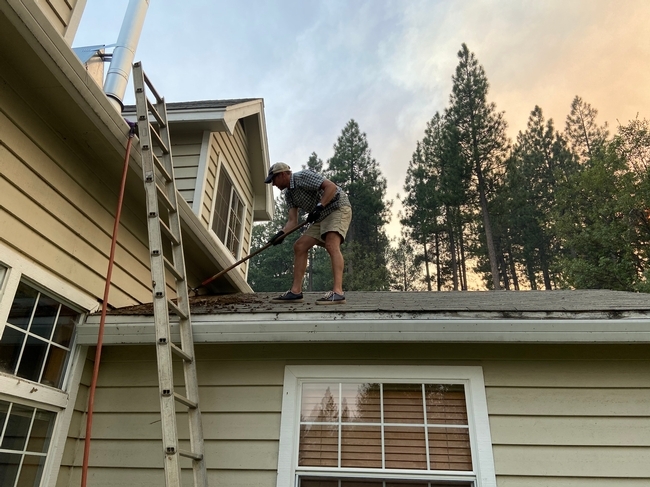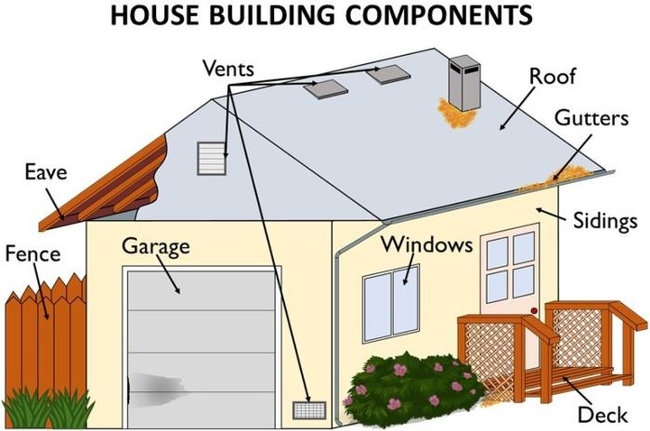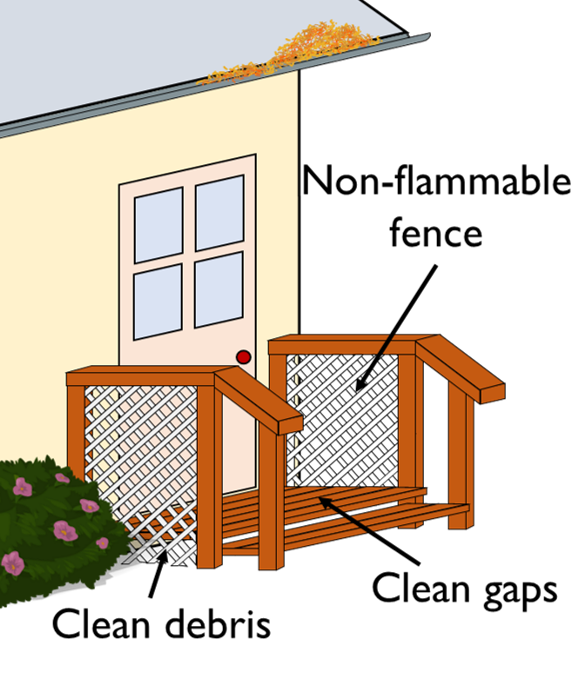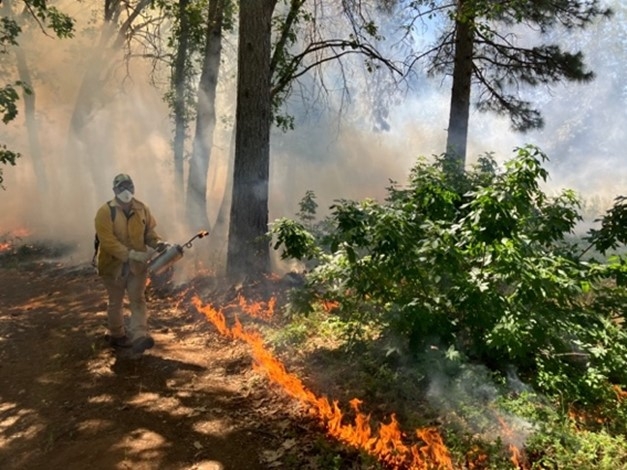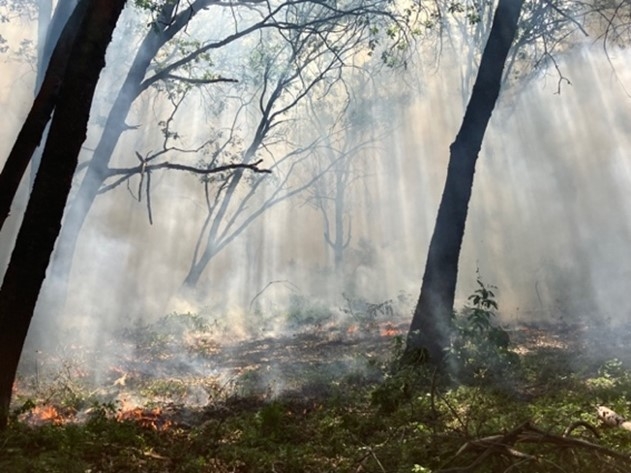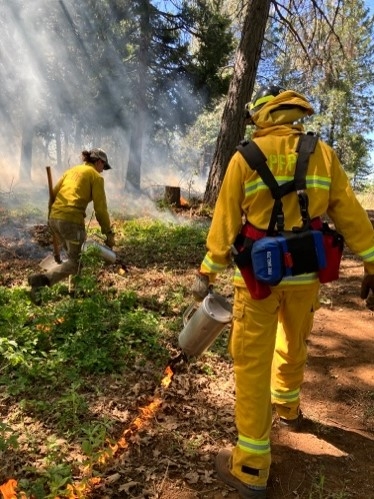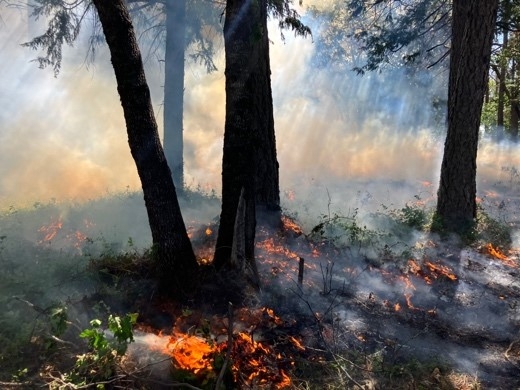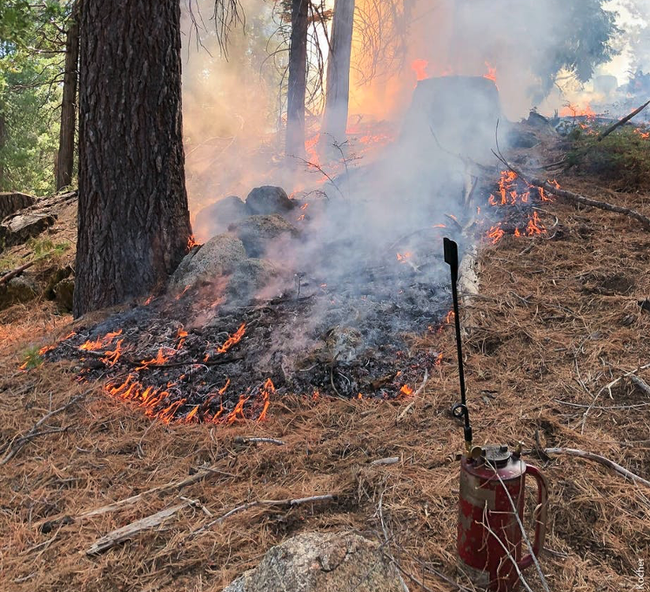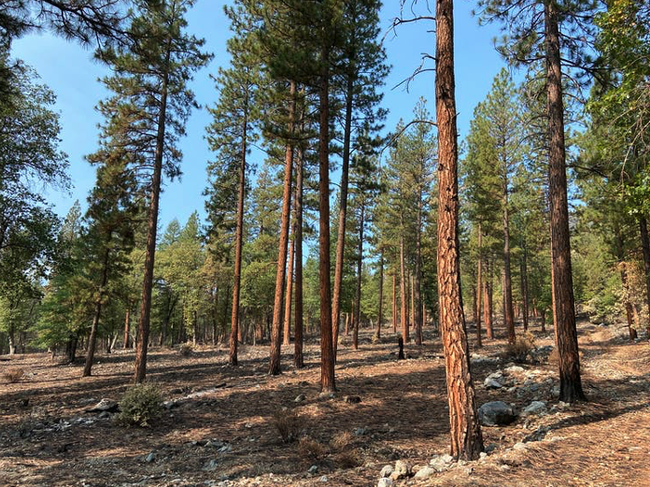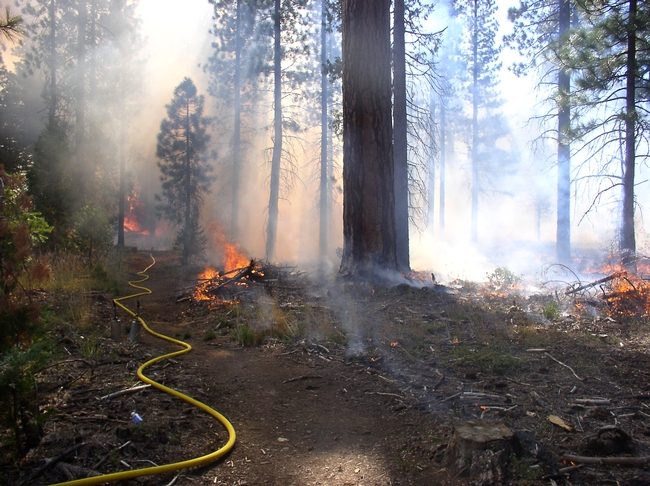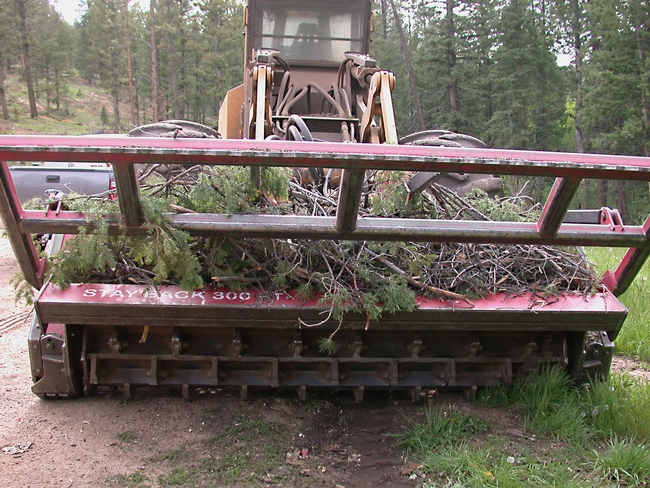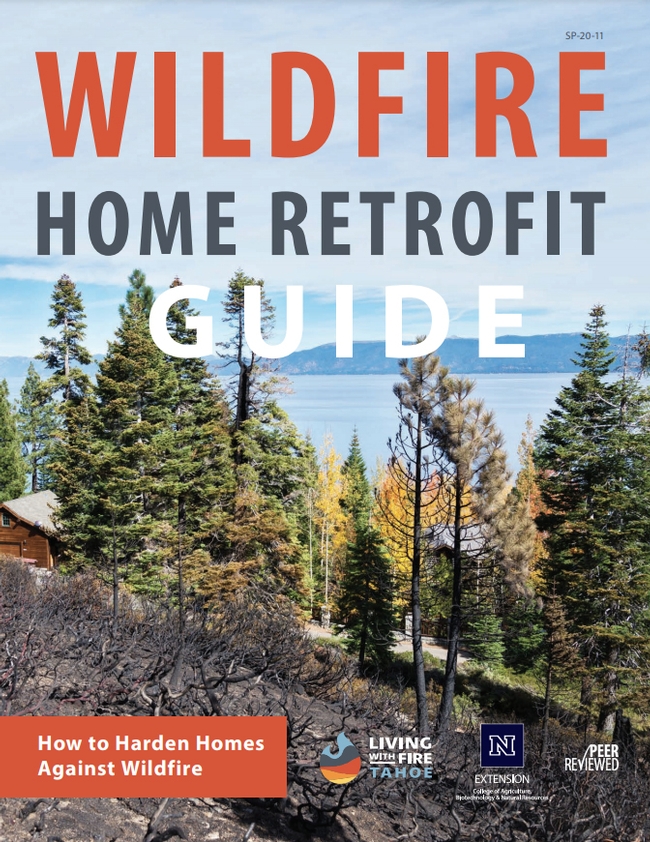Posts Tagged: Susie Kocher
Five things you can do this weekend to help protect your home from wildfire
Despite recent rains, fire remains a danger across California, as there's still plenty of time this fall for grass, woody debris and other flammable material to become dry and ignite.
“The smaller the fuels – pine needles, grass, and small twigs – the faster they can dry out, meaning they will be ready to burn again a few days or weeks after a large rainstorm,” said Susie Kocher, a UC Cooperative Extension forestry and natural resources advisor for the Central Sierra, urging residents to take steps to prevent or limit potential fire damage.
When it comes to “home hardening” and essential wildfire preparations in this age of drought and climate change, not every project requires a bank-breaking budget and an army of contractors.
There are small – but significant – home and landscaping improvements that most people can complete by themselves during a single weekend, with a quick run to the hardware store and some basic planning and safety precautions.
“There are a lot of factors that play into your home's vulnerability to ignition; small changes and upgrades can help reduce some of that risk for people living in high wildfire risk areas,” Kocher explained. “The bigger projects like replacing windows and roofs are very important, but there are definitely smaller projects that people can tackle right away at lower cost that also reduce risk. The main goal of these actions is to reduce the risk that wildfire embers can ignite your home.”
Kocher recommends these five measures as simple but crucial ways to bolster your home's wildfire resiliency.
Clean debris from your roof. Because of its expansive surface, the roof is the most susceptible area of your house to embers. Removing accumulated leaves and needles is especially important if you have a “complex roof” with dormers or other elements – that's where embers gather, too, and could come in contact with flammable siding. (And while you're up there, give those gutters a good swabbing.) Learn more about protecting your roof and gutters.
Install metal flashing in vulnerable spots. Replacing all your siding with noncombustible material can be pricey, but a more manageable task would be adding corrosion-resistant metal flashing to select areas: roof-to-wall intersections, the place where the chimney comes out of the roof, and the edge where the deck meets the house. Learn other ways to shore up your siding.
Remove debris from between the boards of your deck and fence. Embers can ignite leaves and needles stuck between the boards, so be sure to keep those gaps clean and clear. Learn additional steps to harden your deck and prepare your fence.
Take out all vegetation (alive or dead) within five feet of your home. Creating defensible space immediately next to your home is a top priority, so be sure there's nothing combustible within this “Zone Zero.” Plants, mulch, woodpiles, wicker furniture or anything that can catch fire should be removed. Learn what to do in the other “zones” as you move farther from your home.
Inspect vents and upgrade to finer mesh screens. Install or swap in noncombustible, corrosion-resistant metal mesh screening that is at least 1/8” (1/16” would be even better but requires more frequent maintenance). These screens help prevent embers from entering your attic and crawl space. In addition, put together some vent covers that can be deployed if you have time before a wildfire arrives. Learn other ways to reduce vulnerability of vents.
For more in-depth explanations and next steps, Kocher suggests visiting the UC ANR wildfire website (https://ucanr.edu/sites/fire/Prepare) and reviewing this home retrofit guide (https://bit.ly/3RaL54u).
New El Dorado/Amador Prescribed Burn Association conducts first private landowner burns
The new El Dorado/Amador Prescribed Burn association, formed in August 2021, has conducted several burns with private landowners and received funding for a part-time coordinator.
A new group of local residents dedicated to helping private landowners conduct prescribed burns on their own properties has formed in El Dorado and Amador Counties. The group was convened by Susie Kocher, forestry advisor for the University of California Cooperative Extension in the Central Sierra.
“Prescribed Burn Associations, or PBAs, are groups of landowners helping each other to both learn how to use prescribed fire to manage their properties and to help each other carry it out. They have been common in other states in the Midwest and Southeast United States, but are relatively new to California,” said Kocher. The first PBA was formed in Humboldt County and now there are at least 20 in various stages of development throughout the state.
New El Dorado/Amador PBA holds first burns
To date, the local group has held workshops on prescribed burn use, planning and integration with targeted grazing for fuels reduction. The group held their first broadcast burn on May 15, 2022, at LBS Ranch in Placerville. Due to rain in April, the group was able to take advantage of the tail end of the spring burning window. The event served as an educational opportunity for members to get more live fire experience and discuss the planning and implementation process.
Those who attended were landowners, volunteer fire department members, foresters and community members with varying degrees of experience. Together they reduced fuels and resprouting shrubs by burning an acre of forested land that had previously been thinned and masticated. Fire behavior and effects occurred as planned, with low flame lengths and good consumption of live and dead vegetation.
Funding received for part-time coordinator
In April, the University of California Cooperative Extension was awarded funding through a Regional Forest and Fire Capacity subaward from the Watershed Research and Training Center, by a grant awarded by the California Department of Conservation to hire a part-time PBA coordinator. A total of nine PBAs across the state received subawards to fund leadership, peer mentorship, training and travel. The El Dorado/Amador PBA was awarded funding for a half-time coordinator for the next two years. The new coordinator, Kestrel Grevatt, is based at UC Berkeley's Blodgett Forest Research Station and will be splitting her time between the PBA and her role as intern forester at Blodgett. She has a background in fire suppression, prescribed burning and implementing and overseeing fuels reduction work.
Looking forward, the group is planning a burn plan writing workshop for August. This workshop will be intended to help landowners understand the prescribed fire planning process, necessary burn plan components and help them walk away at the end of the day with a drafted burn plan. Attendees will have the opportunity to download and create maps, plan burn units, discuss permits needed and smoke considerations, and write a weather/fuels prescription, all with guidance from PBA leaders and agency representatives. Through the fall and winter, the group's priorities will be to implement burns and make local and regional training opportunities available to members.
“The overall goal of the group is to give community members the support to safely and effectively put good fire on the ground. By starting small, with a few acres at a time, members can learn how to use this tool and develop comfort with fire as a process. Over time, with many landowners' involvement, we can continue to increase the pace and scale of prescribed fire,” said Grevatt.
For more information, please contact Kestrel Grevatt kestrelgrevatt@berkeley.edu.
The work upon which this publication is based was funded in whole or in part through a Regional Forest and Fire Capacity subaward from the Watershed Research and Training Center, by a grant awarded by the California Department of Conservation. The El Dorado / Amador PBA is also supported by UC ANR.
Moving beyond America’s war on wildfire: 4 ways to avoid future megafires
Californians have been concerned about wildfires for a long time, but the past two years have left many of them fearful and questioning whether any solutions to the fire crisis truly exist.
The Dixie Fire in the Sierra Nevada burned nearly 1 million acres in 2021, including almost the entire community of Greenville. Then strong winds near Lake Tahoe sent the Caldor Fire racing through the community of Grizzly Flats and to the edges of urban neighborhoods, forcing the evacuation of tens of thousands of people – including one of us. Those were only the biggest of the 2021 fires, and the risk isn't over. A wind-blown fire that started Oct. 11 was spreading quickly near Santa Barbara on the Southern California coast.
As foresters who have been working on wildfire and forest restoration issues in the Sierra Nevada for over a quarter of a century, we have found it painful to watch communities destroyed and forests continuing to burn to a crisp.
The main lesson we gather from how these fires have burned is that forest fuels reduction projects are our best tools for mitigating wildfire impacts under a changing climate, and not nearly enough of them are being done.
Two historic policies, in our view, led the western U.S. to the point where its forests have become so overgrown they're fueling megafires that burn down whole communities.
Fire suppression
The first policy problem is fire suppression and exclusion.
Fire is an essential ecological process, and many of the ecosystems in the West are adapted to frequent fire, meaning plant and wildlife species have evolved to survive or even thrive after wildfires. But most people arriving in California during colonization, both before and after the Gold Rush of 1849, fundamentally misunderstood the nature of frequent fire forests.
As state and federal agencies evolved policies on forest management, they considered all fire to be an existential problem and declared war. The U.S. Forest Service kicked off a century of fire suppression in the West after the devastating fires of 1910, known as the “Big Blowup” or “Big Burn,” by implementing the 10 a.m. policy. It aimed for full suppression of all fires by 10 a.m. the day after they broke out.
Native people who practiced prescribed fire to manage forests were removed from their homelands, and burning was criminalized. California made prescribed fire illegal in 1924, and it remained illegal for decades until a better appreciation of its importance emerged in the 1970s.
Past harvesting practices lead to regulations
The second policy issue is the regulatory approach that grew out of past logging practices.
Foresters and early California communities were interested in forests for lumber and fuel wood. They sent the largest – and most fire-tolerant – trees to mills to be turned into lumber, which was used to build California's cities and towns.
Poorly executed logging in some areas led to concerns from residents that forest cover and habitat was shrinking. As a result, state and federal regulations were developed in the 1970s that require managers proposing forest projects to consider a “no action alternative.” In other words, maintaining dense forest habitat in the long term was considered a viable management choice.
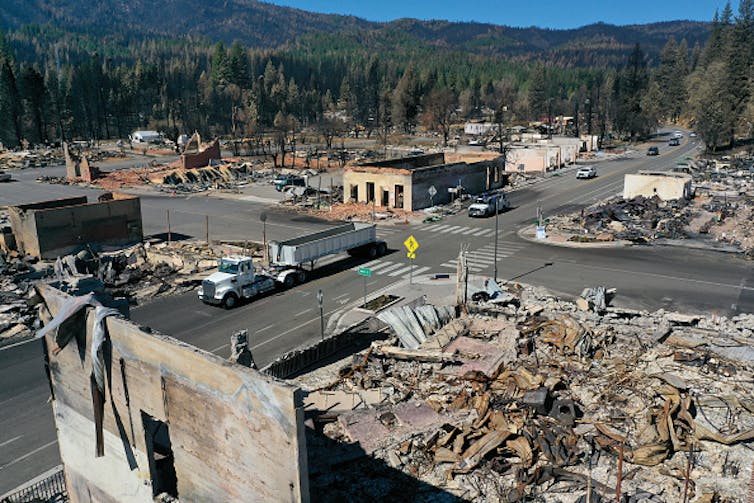
On private land, few owners today thin the forest to levels that would mimic the more fire-resilient forests found in the Sierra at colonization. The California Forest Practices Act until recently required replanting after timber harvest to levels much more dense than were found at colonization. In other words, our current regulatory framework promotes maintaining high levels of forest density, when much more drastic removal of vegetation is needed.
Taken together, these policies have promoted 21st-century forests that are younger, denser and more homogenous – making them vulnerable to increasingly severe disturbances such as drought, insect outbreaks and fire. This new reality is exacerbated by a changing climate, which turns the regulatory assumption that active and widespread forest management is riskier than no management on its head.
Agency priorities change as the crisis grows
Just as forests have changed, so too have the agencies that manage and regulate them. The U.S. Forest Service has seen its budgets for fighting fires balloon while its capacity to proactively manage forests has been shrinking. The California Department of Forestry and Fire Protection, known as CAL FIRE, has also seen large increases in firefighting budgets, though the state legislature has recently moved to increase fire prevention funds, too.
Living in communities threatened by wildfires this summer, we are very grateful to firefighters who have saved our homes. Yet we also are concerned that more large, high-severity wildfires burning across the landscape mean less funding and staff will be available for proactive fuels reduction projects like forest thinning and prescribed fires.

How do we get out of this mess?
The Dixie and Caldor fires that destroyed Greenville and Grizzly Flats provided evidence that forest fuels reduction projects can work.
Both fires burned less severely in areas with proactive forest restoration and fuels management projects, including near South Lake Tahoe and near Quincy.
Fuels reduction projects include thinning out trees, burning off woody debris and reducing “ladder fuels” like small trees and brush that can allow fire to reach the tree canopy. They create more open forests that are less likely to fuel severe megafires. They also create strategic areas where firefighters can more easily fight future blazes. And, because fires burn less intensely in thinned forests, they leave more intact forest after a fire for regenerating new trees and sequestering carbon. Prescribed fires and managed ignitions paid huge dividends for containing the Dixie and Caldor fires.
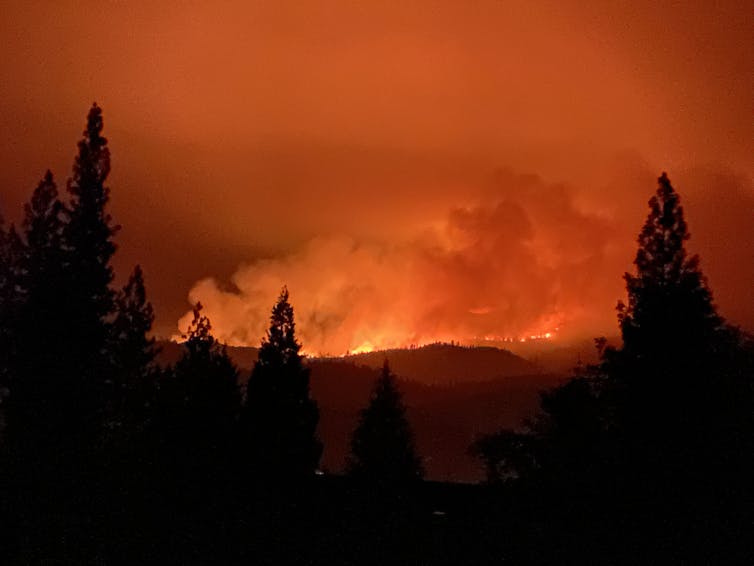
To manage fires in an era of climate change, where drier, hotter weather creates ideal conditions for burning, experts estimate that the area treated for fuels reduction needs to increase by at least an order of magnitude. We believe government needs to accomplish these four things to succeed:
1) Drastically increase funding and staff for agencies' fuels reduction projects, as well as outreach, cost-sharing and technical assistance for private forestland owners. Although the Biden administration's proposal for a Civilian Climate Corps proposes funding to bring in more young and unskilled workers, funding more federal and state agency positions would recruit more natural resource professionals, provide career-track opportunities and better add forest restoration capacity for the long term.
2) Reduce regulations on forest and fuels management efforts for both public and private land. While California and the federal government have made recent strides to streamline regulations, land management agencies need to acknowledge the biggest risk in frequent fire forests is doing nothing, and time is running out. Agencies need to drastically cut the time needed to plan and implement fuels reduction projects.
3) Invest in communities' capacity to carry out local forest restoration work by providing long-term support to local organizations that provide outreach, technical assistance and project coordination services. Funding restoration through competitive grants makes development of long-term community capacity challenging at best.
4) Provide funds and financial incentives for at risk communities to retrofit homes to withstand wildfires and reduce fuels around homes, communities and infrastructure.
Under a changing climate, we will have to learn to coexist with wildfires in the U.S. West, but this will require concerted action and a cultural shift in how we view and manage our forests and communities to be resilient.
Susan Kocher, Cooperative Extension Forester and Natural Resources Advisor, University of California, Division of Agriculture and Natural Resources and Ryan E. Tompkins, Cooperative Extension Forester and Natural Resources Advisor, University of California, Division of Agriculture and Natural Resources
This article is republished from The Conversation under a Creative Commons license. Read the original article.
Proper land management can help forest owners ease wildfire risk following mass tree die-off
The massive die-off of conifers in the Sierra Nevada between 2012 and 2018 was predictable and unprecedented. Sadly, it is also likely to happen again, said UC Cooperative Extension forestry advisor Susie Kocher.
To help landowners manage forests in a way that minimizes the risk of such catastrophic tree die-off and the threat of uncontrolled wildfire, Kocher and two colleagues produced a 20-page publication that summarizes current research on tree mortality and outlines actions that can be taken to make the forest more resilient. The publication, Mass Tree Mortality, Fuels, and Fire: A Guide for Sierra Nevada Forest Landowners, is available for free download from the UC Agriculture and Natural Resources catalog.
Written by Stanford graduate student Devin McMahon (now graduated), UC Berkeley Cooperative Extension forest health specialist Jodi Axelson and Kocher, the publication presents the extent of the die-off in the Sierra Nevada, and describes different factors that contributed to the vast loss of tree life – including land management practices, weather patterns and geography. It includes detailed reporting on the mortality's impacts on fuels and fire risk so landowners and managers can understand and develop strategies to prevent similar destruction in the future.
While about two-thirds of California's 33 million acres of forests are public lands held by state and federal government agencies, the rest is in private hands. Large companies manage millions of acres for commercial timber production, but about 9 million acres are owned by individuals. Nearly 90% of individuals own 50 acres or less; 87,000 landowners have 10 acres or more of forest.
“That's a really large number of people,” Kocher said. “That's one of the reasons why it is so difficult for landowners to manage land to improve forest health and reduce fire risk. It's not economical to do forest management on small areas.”
It's also very complicated. As natural processes play out over time in a forest with mass mortality, the fire risk changes dramatically.
“In the new publication, we help people understand the nuances of forest management so they understand what actions are most appropriate throughout the whole cycle,” she said.
Assessing and addressing the fire risk
The publication provides an overview of fire risk reduction. A table lays out the seven components of fire risk – fuel load, fuel moisture, fuel continuity, probability of ignition, weather conditions, topography and vulnerability to fire – along with mitigation actions for each that landowners can take.
Intentional, controlled burning, or prescribed fire, is often the most effective way to decrease fuel loads and future risk from fires, the researchers wrote. Other management actions include masticating – chewing up brush and branches with specialized equipment – felling and removing dying and dead standing trees, and thinning live trees.
The authors conclude with a glimmer of hope for the future of California forest lands. “Carefully planned forest management can reduce the amount and continuity of fuel on the landscape and limit the risk of destructive fire after tree mortality.”
Protecting homes in wildfire-prone communities covered in new publication
A team of California and Nevada fire scientists have produced a booklet with step-by-step guidance on retrofitting an existing home to be more resilient to fire.
Susie Kocher, UC Cooperative Extension forestry and natural resources advisor and co-author of the new guide, said some homeowners feel powerless to protect their homes against California's increasing wildfire threat.
“I'm happy to tell them that's not true. There are specific actions that we can all take to reduce the likelihood of our homes being burned in wildfire,” said Kocher, who lives in a forested area near Lake Tahoe. “We need to educate ourselves on the details of home construction that make homes less vulnerable to ignition.”
The free 20-page publication, How to Harden Homes against Wildfire (http://ucanr.edu/HomeRetrofitGuide) is now available online. It includes recommendations for 12 vulnerable components of homes in wildfire-prone areas, including roofs, gutters, vents, siding, windows, decks and fences.
In the past, agencies have focused on recommending changes in vegetation and establishing defensible space. However, Kocher said recent advances in wildfire science have exposed vulnerabilities of structures themselves.
“Managing vegetation and retrofitting the home are both needed to decrease wildfire risk and help our communities become more fire adapted,” she said.
CAL FIRE awarded funding to develop and publish the wildfire home retrofit guide, funding that is part of California Climate Investments, a statewide program that assigns cap-and-trade dollars to projects that aim to reduce greenhouse gas emissions, strengthen the economy and improve public health and the environment.
In addition to CAL FIRE, organizations that contributed to the document are University of Nevada, Reno Extension; University of California Cooperative Extension; Living with Fire, Tahoe; Tahoe Fire and Fuels Team; Tahoe Resource Conservation District; and Tahoe Network of Fire Adapted Communities.
The team also hosted three webinars to share home fire resilience information targeted to different audiences. Videos of the webinars are available on the Living with Fire YouTube Channel:
For the public: https://www.youtube.com/watch?v=YX114wpPwmg&t=327s
For building professionals: https://www.youtube.com/watch?v=ccIAIg6xONs
For fire educators: https://www.youtube.com/watch?v=lOsdyVSPxnA&t=177s
(First published Jan. 28, 2021)
UC Agriculture and Natural Resources brings the power of UC to all 58 counties. Through research and Cooperative Extension in agriculture, natural resources, nutrition, economic and youth development, our mission is to improve the lives of all Californians. Learn more at ucanr.edu.


